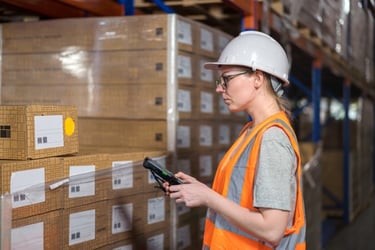Have you seen that the consumer demand for refurbished technology is increasing? Are you thinking about offering these to your own customers?
The technical teams and processes at Ingram Micro Lifecycle have over 30 years of experience in delivering after-sales device support to all the major manufacturers, network operators, and technology resellers across the globe.
Witnessing first-hand the evolution of products, quality, and functionality enable us to innovate. It’s become our blood and our passion as we learn these products inside and out.
If you’re unsure of what’s driving the trend toward refurbished devices, read on as we’ll uncover seven of the top reasons why consumer attitudes have changed.
The "reduce, reuse, recycle" mantra
Our escalating reliance on technology has grown in the last few decades. This means more electronic devices and gadgets in circulation, particularly in more affluent communities. These have a limited lifespan and will become e-waste.
For those in less developed economies, the processes for waste handling and disposal are not as advanced or efficient as those in more developed economies.
The typical lifespan of a smartphone is 4-7 years. In reality, this is tied to the duration of the network operator contract so is often shorter. When these devices become discarded, they either go to the landfill, get recycled, or become idle in drawers and cupboards.
While recycling remains an option for unwanted technology, the material reclamation from this process must be financially feasible. The amount of technology gathered and the costs (of collection and processing) impact this.
The process must be refined to ensure a worthwhile yield. The recycling of e-waste currently focuses on high-volume materials. This includes glass, plastics, and copper.
With technology diversifying, so too do the materials used in creation. The capabilities of the recycling process must increase to reclaim different materials.
Consumers are facing increased technology costs but also peer pressure from society to own the latest and greatest. Reducing the technology we use becomes more difficult when we are so reliant on it. This puts the ownership of devices into question.
If we want or need the devices, do we have to own them? Gadgets and high-end consumer electronics are available through a variety of leasing companies. This provides access to the product for a monthly fee.
At the end of the lease, the user returns the device where it goes through repairs and refurbishment ahead of re-lease. This reduces the cost of acquisition for the consumer and ensures the devices remain in use for longer.
What is the refurbishment process?
Any used, second-hand, or returned electronic devices must first be data wiped. This ensures devices no longer house residual data before reaching the hands of the next user. This is compliant with data protection regulations.
The devices are then screened to assess the level of refurbishment needed. Devices deemed beyond economic repair are stripped of useable parts for the remanufacturing of other similar devices. The remainder is recycled. The refurbishment needed on devices is cosmetic, such as scratches. In some cases, parts will need to be swapped out such as LCD screens or batteries.
The operating system on the devices is updated so the product is working to the greatest condition. It is then repackaged with all the necessary accessories. These include power cables, charging leads, and earphones (depending on the device).
When the product is presented in a like-new, near-original state, it’s remarketed and sold via eCommerce channels or to buyers, ready to be re-used.
How have consumer mindests towards refurbished devices changed?
When the lifecycle extension of technology via refurbishing was a new process, it failed to live up to consumers’ expectations. The process led to uncertainties around performance and quality.
In 2020, one online auction retailer reported an increase of 120% in sales of certified refurbished electronics during the Thanksgiving weekend.
According to GSMA, the refurbished mobile device market was worth $49.9bn in 2020 and is expected to grow to more than $140bn by 2030.
These figures show that the demand for refurbished devices is growing. Seven different phenomena have led to increased consumer acceptance and demand.
1. Availability
Global issues have affected the supply chain of products – some parts can be more difficult to acquire. This has a knock-on effect and reduces the availability of goods in a market. COVID-19 saw an unforeseen demand for mobility IT equipment, such as laptops.
This followed the shift to remote or hybrid working. The supply of new electronics dropped and more people turned to refurbished goods. This meant increased use of these products and users were better able to judge the quality for themselves. The good experience they had made them more desirable.
2. Brand assurance
More manufacturers are diversifying to offer refurbished as well as new stock. Consumers have confidence and loyalty to the brands they recognize and trust. They are more likely to buy refurbished stock from these names.
3. Guarantees
More brands are offering refurbished products with a quality guarantee. These provide more confidence to the consumer that the product is going to suit their needs. Return rights allow them to get their money back should the refurbished product fail to meet expectations.
4. Quality
The processes behind refurbishing a product have come a long way. Now, higher standards are in place to meet the demand of the end user. As technology refines and innovative solutions are discovered, processes will be positively impacted. As quality increases, so too do the peer recommendations to buy refurbished goods.
5. Economy
The cost-of-living crisis impacting many communities means that disposable income has decreased. The Eurobarometer study in 2022 reported that rising prices, inflation, and the cost of living are the leading issues that Europeans say they are personally facing.
Those watching their pennies can no longer afford the luxury of buying new devices.
Manufacturing costs for technology have also increased which has an impact on the retail prices of goods.
Refurbished technology is a cheaper alternative for cost-conscious consumers.
6. Accessibility
The trajectory of the popularity of refurbished devices is correlating with access. More and more retailers are offering refurbished devices alongside new ones.
Whether consumers shop online or in-store, there’s likely to be a retailer nearby with a refurbished device option. Ease of access to these options makes the consideration of the choice more likely.
7. Environmental Awareness
The extraction of raw materials and pollution does irreversible damage to our planet. The awareness around this is growing. Consumers are considering their environmental footprint more now than ever before. Public health experts warn about the rising impact of eco-anxiety.
Coffey et al, 2021 describe this as “the distress caused by climate change where people are becoming anxious about their future”. E-waste is scaling at a rapid rate and new technology on a linear lifecycle adds to it.
GSMA reported that by 2030, up to 21.4 million tonnes of CO2 emissions could be saved annually by extending the lifetime of all global smartphones for an extra year. This would have the same impact on CO2 emissions as taking more than 4.7 million cars off the road.
Can Ingram Micro Lifecycle help me source refurbished devices?
These are seven clear reasons why consumers are demanding more refurbished electronics and why you should be considering supplying these alongside new products.
Our experienced recommerce team can source refurbished devices for our customers and have the support in place to facilitate whatever logistics and repairs that are necessary. You can find out more on our services page. Our skilled repair and refurbishment teams offer innovative solutions, such as refurbishing and replacing LCDs.
Continue learning with these helpful articles
- How Quickly do Smartphone Returns Depreciate?
- How Can Your Business Reduce Corporate E-Waste?
- 5 Ways a Circular Economy Boosts Your Sustainability Goals













